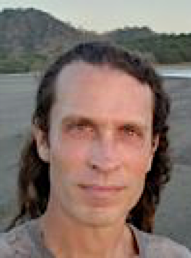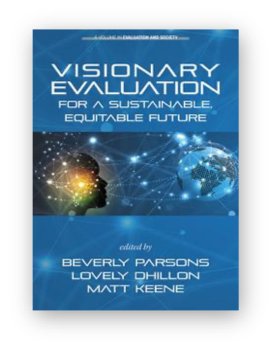Hi, I’m Matt Keene, part of the team of editors and authors of Visionary Evaluation for a Sustainable, Equitable Future, a book set in 2030. It’s about social (r)evolutions and evaluation’s role in transformative change for a future of shared well-being. Spoiler Alert! A lot of the work is done by Visionary Evaluatives. Who are they?! Lucky you. This week, six Visionary Evaluatives will share what they are doing to spark your imagination and light a fire under your praxis.

What is a vision of a future you want? As a Visionary Evaluative, I am, and will be, asking this question of anybody I can sneak up on. Waiting to cross the street, paying for beets and brussels sprouts, while our kids ignore us. This spring I’ll ask as I push peas and heads of lettuce onto neighbors passing by. So far, I’m coming across three types of vision.
- Personal/Micro – “I can’t wait to get/quit my job as a policy analyst!” I live in Washington DC.
- Global/Macro – “A healthier, safer, fairer world.” Noble but usually lacking inspiration.
- Minimal – Gaze moves up and to the left. “That’s interesting…Matt, it’s been real. Talk soon. Gotta goooooo!”

Visioning, designing futures we want to create, is not natural for most of us. Why would it be? When the future is very much like the past and the present – as, evolutionarily, it has been – and you are pretty okay with that, vision isn’t that critical. So we aren’t that good at it. But from now on, we need to be.
Why now? The likelihood is increasing that:
- The future will be different from the past, and
- The difference between the past and future is increasing.
This is a time of accelerating change. The future is likely to look very different from the past. Perhaps unrecognizable. We might let ourselves be swept along with the momentum of modernity, allowing our future to spin out of what a few of us have already created, in the past, in different times. But if we are to have a say in the future we get, we’ll need a more disciplined, purposeful evolution. Vision is required.
Vision may not be altogether natural, yet, but it may be moral. I see an expansion of our moral range where we find our values compelling us to share and cultivate each other’s visions.
Hot Tip: Ask yourself, what visions would you introduce to a world that crafts, shares, and nurtures our future?
Our book is filled with dialogue, even a screenplay(!), designed to inspire inquiry and conversation. Dig in.
It explains what a Visionary Evaluative (VE) is and the principles guiding VEs.

Rad Resource: Interested in predictable mistakes in an unpredictable future? Read Nassim Nicholas Taleb.
The American Evaluation Association is celebrating the publication of Visionary Evaluation for a Sustainable, Equitable Future, an outgrowth of the Evaluation 2014 conference theme with the same name. The contributions all this week to aea365 come from editors and authors of the book. Do you have questions, concerns, kudos, or content to extend this aea365 contribution? Please add them in the comments section for this post on the aea365 webpage so that we may enrich our community of practice. Would you like to submit an aea365 Tip? Please send a note of interest to aea365@eval.org. aea365 is sponsored by the American Evaluation Association and provides a Tip-a-Day by and for evaluators.

